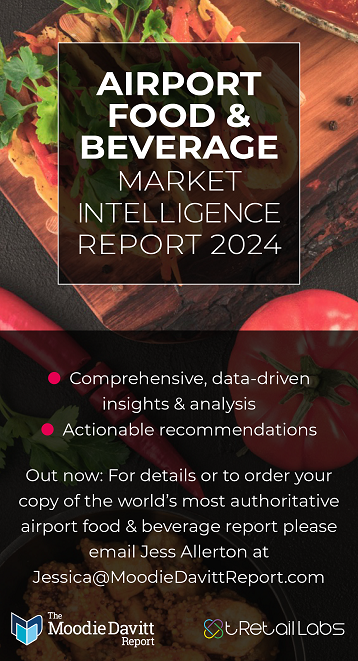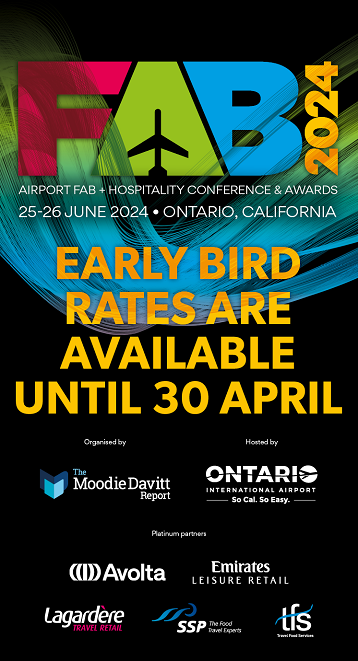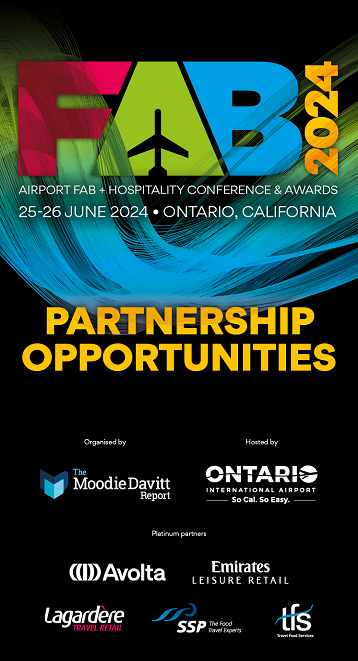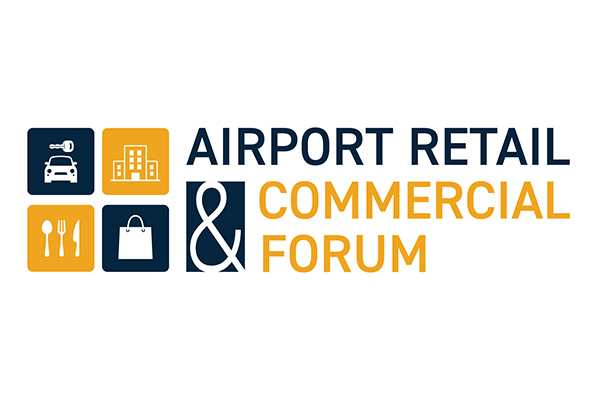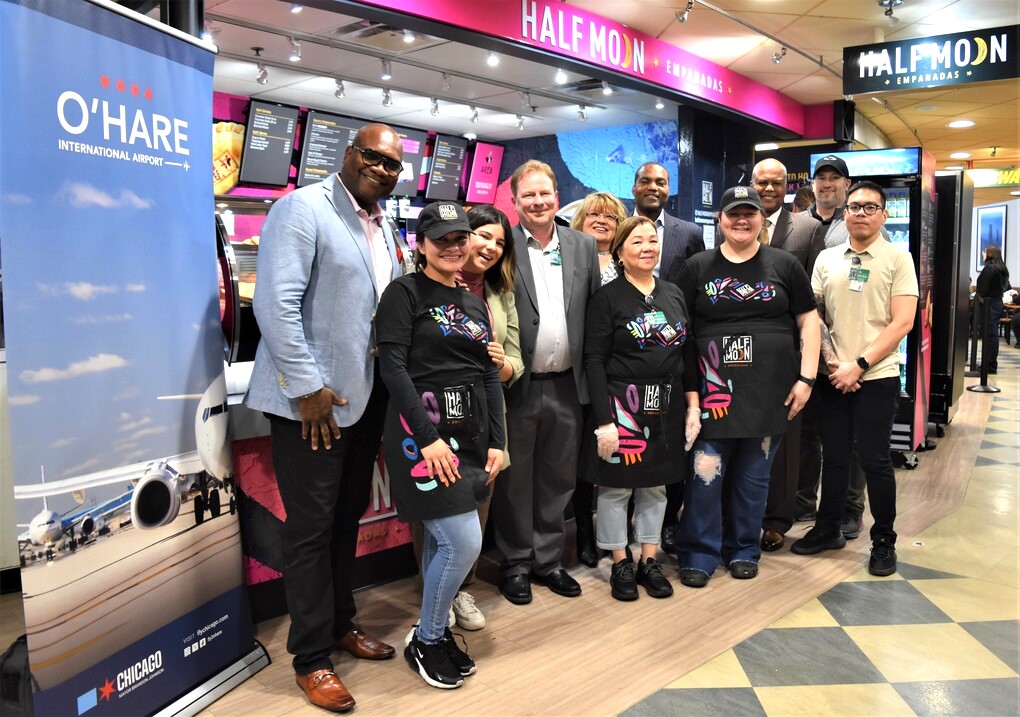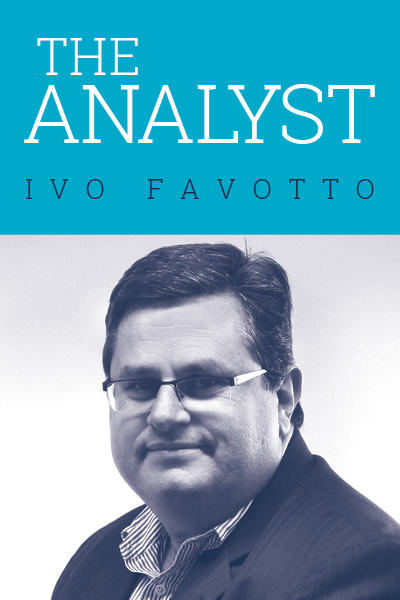
The Moodie Davitt Report introduces the latest feature in The Analyst series, written by The Mercurius Group Founder & President Ivo Favotto*. Here the long-time travel retailer, now Sydney-based consultant, assesses the rise of airport food & beverage and whether it has the potential to replace specialty retail as the threat of e-commerce looms.
The views expressed in this column are not necessarily those of the publisher.
It’s the Airport Food & Beverage (FAB) 2017 Conference in Toronto. Great city, wonderful venue, warm June weather. Everybody is enjoying the celebration of food, food service and the business insight that is FAB. And then San Francisco Airport Director Revenue Development and Management Cheryl Nashir hits the podium and starts her presentation.
THUD!
Was that the sound of a canary hitting the bottom of a bird cage?
To paraphrase Nashir (the text of her speech is not available but I checked with five others also at FAB to make sure I heard it right), she said that San Francisco Airport (SFO) is considering reducing the amount of specialty retail and replacing it with food & beverage. Why? Because at SFO, the return per square foot for both categories is nearly the same and F&B is currently growing where retail is not.
Did I hear that right? Switching out specialty retail for F&B? And the return is nearly the same?
Well, according to my benchmarks – and those featured in The Moodie Davitt Report’s Airport Commercial Revenues Study (ACRS) – the returns might be nearly (but not quite) the same in some domestic terminals. However, in international terminals, it’s not even close – specialty retail (when done right) should generate much higher returns per square foot (or metre), even double.

Yet, here is Nashir, a much-respected executive representing one of the largest and most sophisticated airports in North America, telling us that specialty retail is on the slide to the extent that she wants to switch it out. It can’t be right, can it?
Is Cheryl Nashir travel retail’s proverbial canary in the mineshaft, reacting to the dangerous carbon monoxide gas?
Then I thought about it some more. Nashir works in San Francisco, the epicentre of the e-commerce revolution, home to Silicon Valley and home to Apple Inc. If retail was going to suffer at the hands of e-commerce anywhere, it would probably happen first in a place like San Francisco, amongst all those hipsters, tech heads and early adopters.
Maybe what Nashir is experiencing at SFO is signalling an emerging trend – is she travel retail’s proverbial canary in the mineshaft, reacting to the dangerous carbon monoxide gas? Maybe SFO is one of the first airports in the world to feel the same winds of change that have been occurring in the domestic retail landscape? Or maybe she’s the first to call it (or the first one that I have heard, at least). As an industry, we’ve had multiple conference events – including The Moodie Davitt Report’s Trinity Forum – warning of the potential impact of e-commerce but not actually reporting a real embodiment such an impact. Has e-commerce’s impact on domestic downtown retailing finally appeared at an airport?
We know that good quality dwell time adds significantly to an airport’s commercial performance. But there’s only so much of it to go around.
Is specialty retail in airports really on the wane? Should airports around the world be thinking about swapping specialty retail for food & beverage? It would be kind of a self-fulfilling prophecy wouldn’t it? F&B is a dwell time sinkhole.
Dwell time is (largely) finite and very precious. We know that good quality dwell time adds significantly to an airport’s commercial performance. But there’s only so much of it to go around. As F&B grows, and it moves away from fast food and quick service restaurants towards prepared-to-order specialty cuisine and celebrity chef outlets, the less time passengers will have to dwell and spend in other areas of the terminal, including retail. Embarking on a shift towards F&B could put increasing performance pressure on specialty retail, creating a vicious circle as airports chase returns.
So perhaps there should be some pause for thought before airports launch into such action, en masse.
I know that the growth in F&B is a happening trend in downtown precincts and in the mall industry. The media is full of stories, especially in the USA, foretelling the demise of shopping malls, especially in suburban areas – or at least the demise of specialty retail in those shopping centres. But what is growing in suburban shopping malls is F&B.
F&B is taking up an increasing proportion of space within each new development and this is not just food courts but food experience and food theatre. F&B is arguably becoming the main attraction drawing people to shopping centres and has hence become crucial to their survival.
But airports are different, aren’t they? Well perhaps not. The vision of food & beverage-dominated airport terminals lurked in the back of my mind for the rest of what was an excellent and thought-provoking presentation by Nashir, and for the rest of the conference.
Then as circumstances would have it, I transited through San Francisco Airport on my way back to Sydney, so I decided to take the time to have a good look around to see if I could spot what Nashir was talking about at FAB.
And what I saw gave me some heart that all is not yet lost for specialty retail. While San Francisco Airport is one of the more progressive airports for retail in the USA, it still suffers from what I call USA-airport “terminal-itis”: an historic legacy of long skinny piers driven by aircraft wingspan geometry with infill retail outlets spread out along the pier, much of it capturing neither 100% footfall nor 100% dwell, far from it in fact. Not the kind of soaring retail precincts that other market-leading airports around the world have developed that help to deliver much better returns from specialty retail than F&B. The kinds of retail precincts that do capture 100% footfall and 100% dwell.
So while all may not be lost, at least not yet, we all should take heed of Nashir’s warning. She may indeed be the sentinel warning us of what is to come. Maybe, Nashir wasn’t intending to be a sentinel, but in any case, we have been warned.
All this is not to deny F&B’s inexorable rise. It’s a retail category whose time in airports has finally come, and all for the better. It’s just not time (yet) to kill off specialty retail.
Please visit The Mercurius Group website for more information and analysis.
Previous articles by The Analyst:
A tale of two regions in Australia’s airport development
Does providing a free parking period give you social licence to charge more for car parking?
Car parking spots becoming like airline seats
Australian downtown tax free shopping outstrips airport duty free
‘Brexit’ and the five stages of grief
What does ‘Brexit’ spell for European travel retail?
Australia bucks retailer consolidation trend
*About Ivo Favotto
Ivo Favotto has a long and distinguished record in the airport and travel retail sectors. A trained economist, he entered the airports/infrastructure sector with Australia’s Federal Airports Corporation in 1992 as GM – Planning & Economics.
He later built a highly successful international airports/infrastructure consulting practice, working with three firms – Bach Consulting, Arthur Andersen and URS Corp – and advising many of the world’s leading airports, governments and investors in the areas of retail planning, master planning and privatisation/transaction support.
In 1998 he established the market-leading Airport Retail Study, selling it to Moodie International so he could join The Nuance Group (now owned by Dufry) as Executive Vice President – Strategy & Business Development in Zürich. He later returned to his native Australia as Director – Sydney Airport before being named Executive General Manager of Duty Free & Luxury, Pacific for Lagardère Travel Retail.
 He has now formed The Mercurius Group, a Sydney-based consultancy focused on industry research, consultancy and benchmarking studies. The company also assumes responsibility for revamping and relaunching The Airport Commercial Revenues Study (ACRS), which Ivo founded (as The Airport Retail Study) and sold to Moodie International in 2007 as part of an informal alliance between Mercurius and The Moodie Davitt Report.
He has now formed The Mercurius Group, a Sydney-based consultancy focused on industry research, consultancy and benchmarking studies. The company also assumes responsibility for revamping and relaunching The Airport Commercial Revenues Study (ACRS), which Ivo founded (as The Airport Retail Study) and sold to Moodie International in 2007 as part of an informal alliance between Mercurius and The Moodie Davitt Report.
Contact: Tel: +61 423 564 057; E-mail: ifavotto@themercuriusgroup.com; Website:www.themercuriusgroup.com




